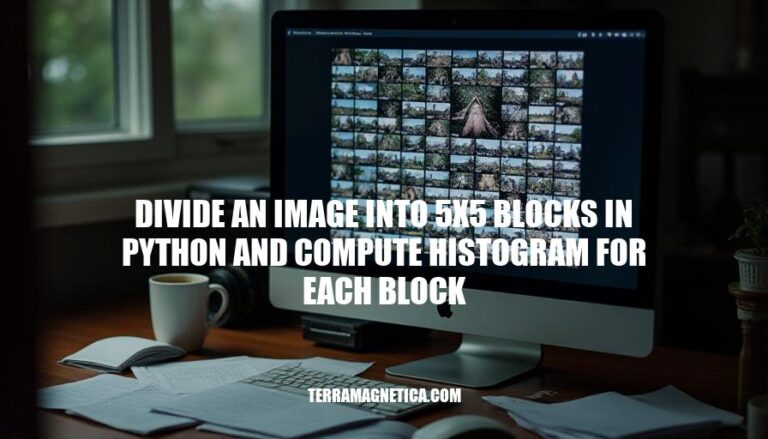


Dividing an image into smaller blocks and computing histograms for each block is a common technique in image processing. Here’s a brief introduction on how to do this in Python:
cv2.calcHist().This technique helps in analyzing localized features within an image, which is crucial for tasks like texture analysis, object recognition, and image segmentation. By examining histograms of smaller regions, we can capture more detailed information about the image’s content and structure.
Would you like a sample code snippet to get started?
Here are the necessary libraries and tools:
cv2)numpy)matplotlib)These libraries will help you divide an image into 5×5 blocks and compute histograms for each block.
Here’s a detailed step-by-step guide on how to divide an image into 5×5 blocks in Python and compute the histogram for each block:
First, you need to import the necessary libraries. We’ll use OpenCV for image processing and NumPy for array manipulations.
import cv2
import numpy as np
import matplotlib.pyplot as plt
Load the image using OpenCV.
image = cv2.imread('path_to_your_image.jpg')
Get the dimensions of the image to determine the size of each block.
height, width, channels = image.shape
block_size_x = width // 5
block_size_y = height // 5
Loop through the image and divide it into 5×5 blocks.
blocks = []
for i in range(5):
for j in range(5):
block = image[j*block_size_y:(j+1)*block_size_y, i*block_size_x:(i+1)*block_size_x]
blocks.append(block)
Compute the histogram for each block. We’ll use the cv2.calcHist function.
histograms = []
for block in blocks:
hist = cv2.calcHist([block], [0], None, [256], [0, 256])
histograms.append(hist)
Finally, plot the histograms for visualization.
for i, hist in enumerate(histograms):
plt.subplot(5, 5, i+1)
plt.plot(hist)
plt.xlim([0, 256])
plt.show()
Here’s the complete code for reference:
import cv2
import numpy as np
import matplotlib.pyplot as plt
# Load the image
image = cv2.imread('path_to_your_image.jpg')
# Get image dimensions
height, width, channels = image.shape
block_size_x = width // 5
block_size_y = height // 5
# Divide the image into 5x5 blocks
blocks = []
for i in range(5):
for j in range(5):
block = image[j*block_size_y:(j+1)*block_size_y, i*block_size_x:(i+1)*block_size_x]
blocks.append(block)
# Compute histogram for each block
histograms = []
for block in blocks:
hist = cv2.calcHist([block], [0], None, [256], [0, 256])
histograms.append(hist)
# Plot histograms
for i, hist in enumerate(histograms):
plt.subplot(5, 5, i+1)
plt.plot(hist)
plt.xlim([0, 256])
plt.show()
This code will divide your image into 5×5 blocks and compute the histogram for each block, then plot them for visualization.
Here’s a complete Python code implementation to divide an image into 5×5 blocks and compute the histogram for each block. The code is well-commented for clarity:
import cv2
import numpy as np
import matplotlib.pyplot as plt
# Load the image
image = cv2.imread('path_to_your_image.jpg', cv2.IMREAD_GRAYSCALE)
# Get the dimensions of the image
height, width = image.shape
# Define the size of each block
block_size = 5
# Calculate the number of blocks along the height and width
num_blocks_height = height // block_size
num_blocks_width = width // block_size
# Function to compute histogram for a given block
def compute_histogram(block):
hist = cv2.calcHist([block], [0], None, [256], [0, 256])
return hist
# Loop through each block and compute the histogram
for i in range(num_blocks_height):
for j in range(num_blocks_width):
# Extract the block
block = image[i*block_size:(i+1)*block_size, j*block_size:(j+1)*block_size]
# Compute the histogram for the block
hist = compute_histogram(block)
# Plot the histogram
plt.figure()
plt.title(f'Block ({i}, {j}) Histogram')
plt.xlabel('Pixel Value')
plt.ylabel('Frequency')
plt.plot(hist)
plt.xlim([0, 256])
plt.show()
cv2.imread.image.shape.compute_histogram is defined to compute the histogram of a given block.matplotlib.Feel free to replace 'path_to_your_image.jpg' with the actual path to your image file.
Here’s a Python example using OpenCV and Matplotlib to divide an image into 5×5 blocks, compute the histogram for each block, and display the results:
import cv2
import numpy as np
from matplotlib import pyplot as plt
# Load the image in grayscale
image = cv2.imread('path_to_your_image.jpg', cv2.IMREAD_GRAYSCALE)
# Define block size
block_size = 5
# Initialize list to store histograms
block_histograms = []
# Iterate over blocks
for i in range(0, image.shape[0], block_size):
for j in range(0, image.shape[1], block_size):
# Extract block
block = image[i:i+block_size, j:j+block_size]
# Compute histogram
hist = cv2.calcHist([block], [0], None, [256], [0, 256])
block_histograms.append(hist)
# Plot histograms for the first few blocks
plt.figure(figsize=(10, 5))
for idx, hist in enumerate(block_histograms[:10]):
plt.subplot(2, 5, idx + 1)
plt.plot(hist)
plt.title(f'Block {idx + 1}')
plt.tight_layout()
plt.show()
cv2.calcHist, which shows the distribution of pixel intensities within that block.This method allows localized analysis of the image, which can be useful for tasks like texture analysis or feature extraction. Feel free to try it with different images and block sizes!
Using OpenCV and Matplotlib in Python, you can divide an image into 5×5 blocks and compute histograms for each block. Here’s how to do it: